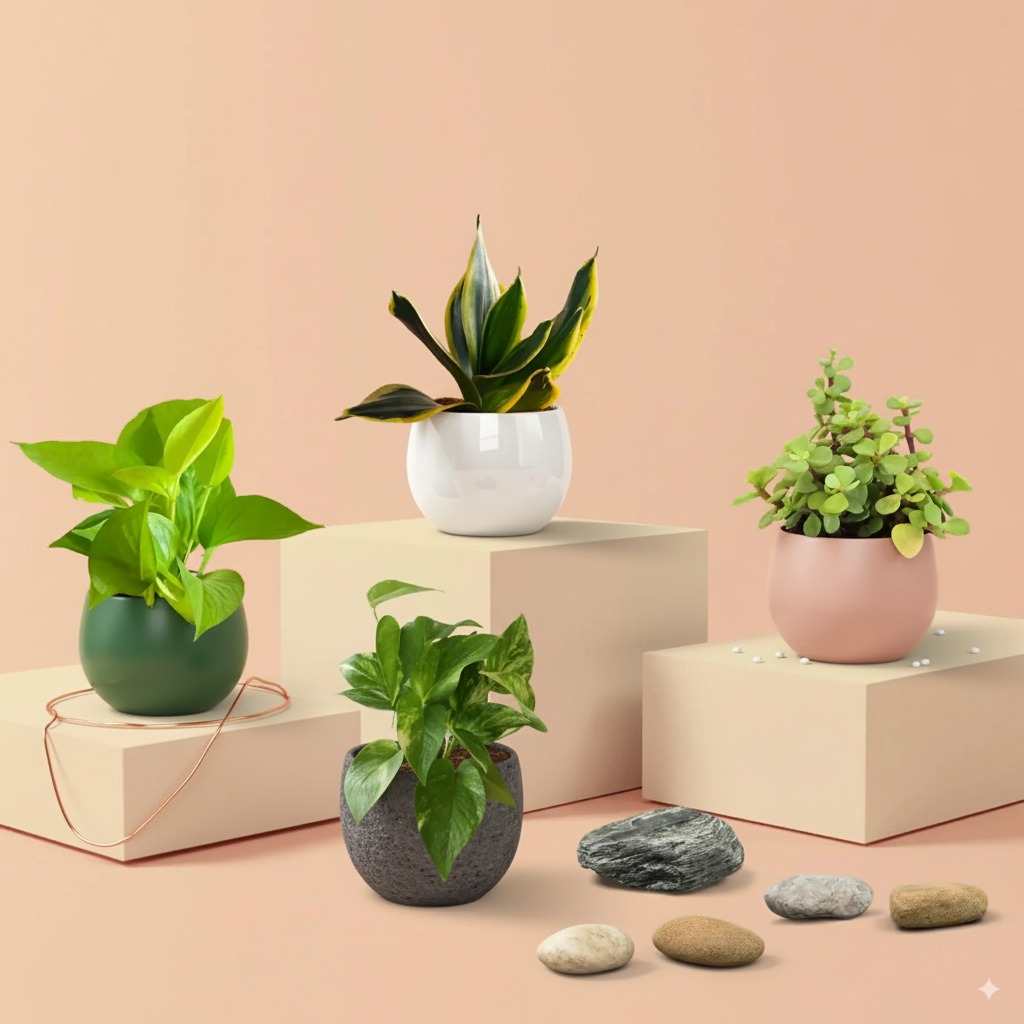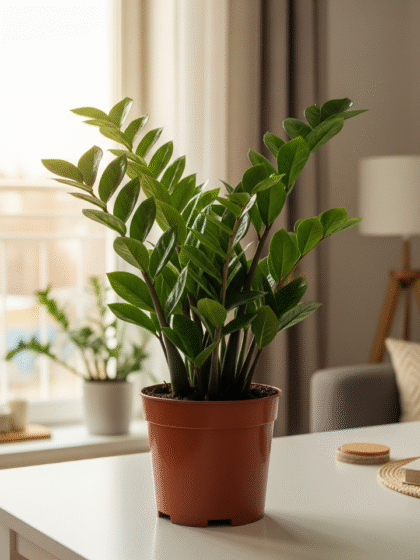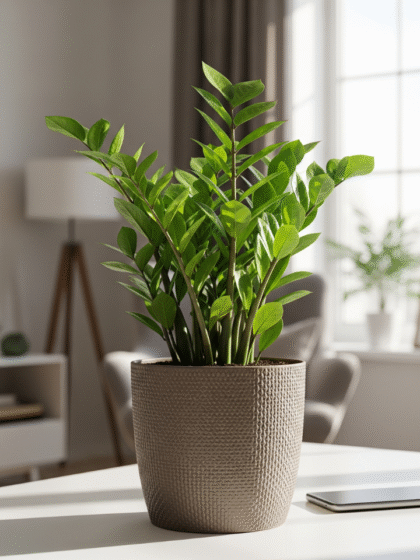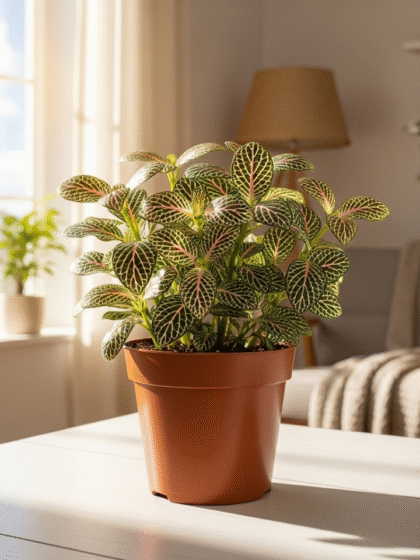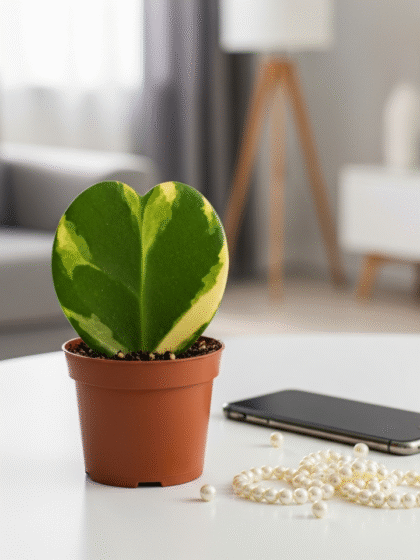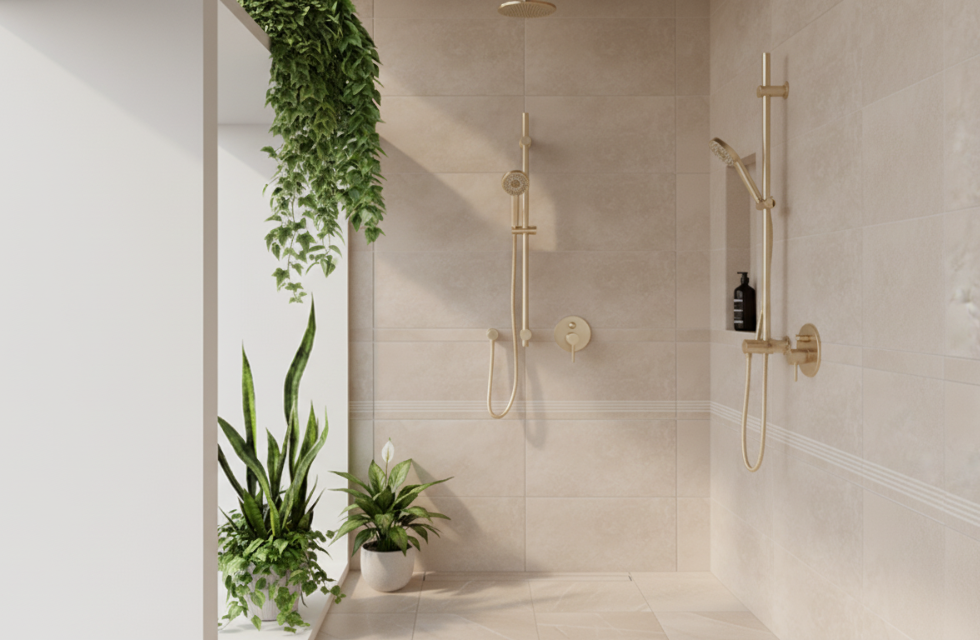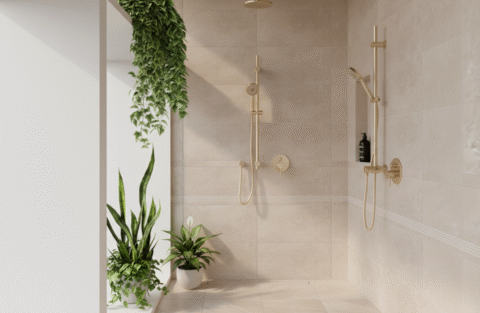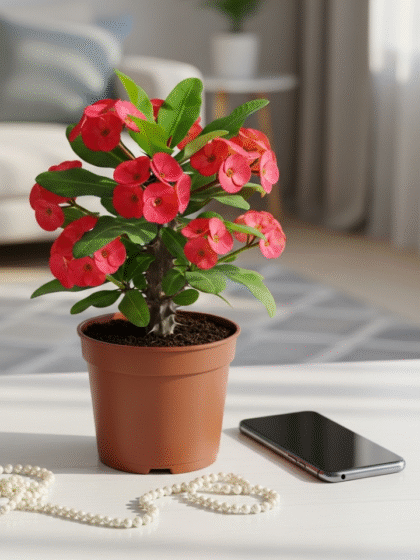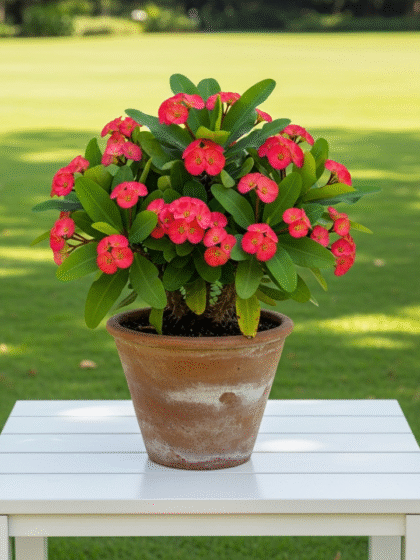Bathrooms are naturally humid spaces — filled with warm steam, limited airflow, and constant moisture. Over time, this damp environment can lead to mold growth, unpleasant odors, and even damage to walls or tiles. But there’s a simple, natural, and beautiful way to tackle this — adding the right bathroom plants.
Certain plants act like living dehumidifiers. Through a process called transpiration, they absorb excess moisture from the air and release clean oxygen in return. This helps to balance humidity levels, reduce mold formation, and create a fresher, healthier atmosphere.
Beyond their functional benefits, these plants also add a soothing, spa-like charm to your space. Imagine stepping into a bathroom surrounded by lush greenery — it instantly feels calmer, cleaner, and more inviting. Whether your bathroom has bright sunlight or none at all, there’s a perfect moisture-loving plant to fit your space and style.
In this guide, we’ll explore the top five bathroom plants that naturally absorb moisture, prevent mold, and keep your bathroom fresh year-round.
Selection Criteria: Light, Ventilation, Space, and Pet Safety
Before you bring home a new plant for your bathroom, it’s important to understand that not all plants thrive in humid or low-light spaces. Bathrooms often have fluctuating temperatures, limited sunlight, and minimal airflow — conditions that can challenge many houseplants. To help your green companions flourish, here are the key factors to consider:
- Light Availability
The amount of natural light your bathroom receives plays a major role in choosing the right plant.
- Bright, sunny bathrooms: Opt for humidity-loving plants like Boston Ferns or English Ivy.
- Low-light or windowless bathrooms: Choose hardy species such as Peace Lilies, Air Plants, or Spider Plants that can survive under artificial or diffused light.
Pro Tip: If your bathroom lacks natural light, consider using LED grow lights to simulate sunlight and support healthy growth.
- Ventilation
Proper ventilation is crucial to prevent stagnant moisture, which can harm both your plants and your bathroom walls.
- Keep a small exhaust fan or open the window occasionally to ensure air circulation.
- Plants like Spider Plants and Boston Ferns thrive in moderate airflow and help keep your bathroom air cleaner and fresher.
- Space and Placement
Bathrooms are often compact, so choose plants that fit the layout:
- Use hanging planters, wall-mounted pots, or corner shelves to maximize space.
- Air Plants or English Ivy work wonderfully in vertical displays or hanging baskets, while smaller Peace Lilies can rest beautifully on countertops or windowsills.
- Pet Safety
If you share your home with pets, it’s essential to choose non-toxic options.
- Pet-safe plants: Spider Plants, Boston Ferns, Air Plants
- Toxic to pets: Peace Lily, English Ivy — keep them on high shelves or out of reach.
Always double-check plant toxicity before purchase, ensuring your green corner is safe for every family member — including your furry friends.
Best Bathroom Plants to Reduce Humidity: Top 5 Green Picks at a Glance
If you want to turn your bathroom into a refreshing, spa-like retreat without worrying about mold or excessive moisture, here’s your perfect plant shortlist. These five moisture-absorbing plants thrive in humid spaces, purify the air, and add a lush, calming vibe to your bathroom — all while demanding minimal maintenance.
Below is a quick overview of each one, followed by detailed sections for every plant.
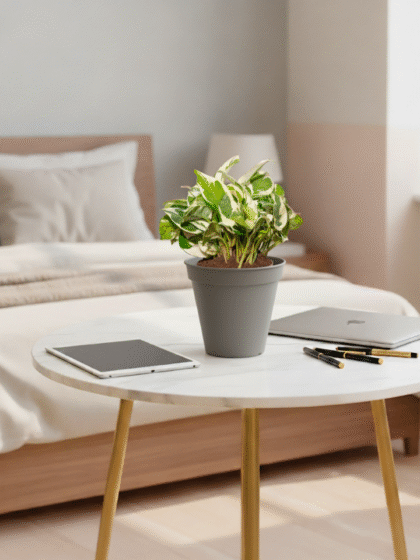

Money Plant N’Joy


Peperomia Green Creeper Plant


Snake Plant (Golden Hahnii)
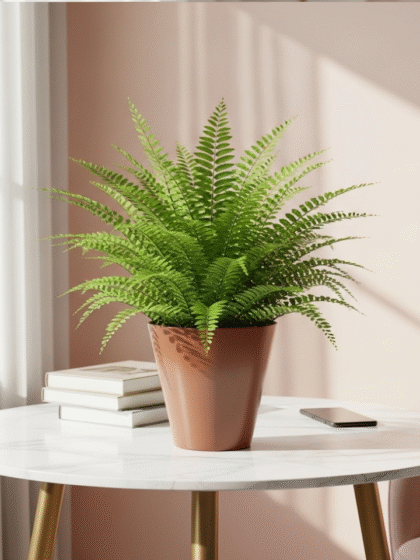
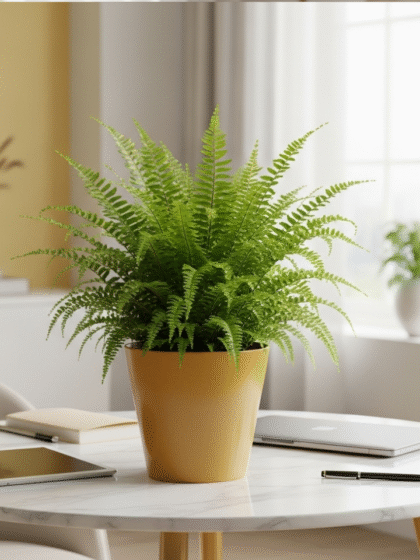
Boston Compacta Fern
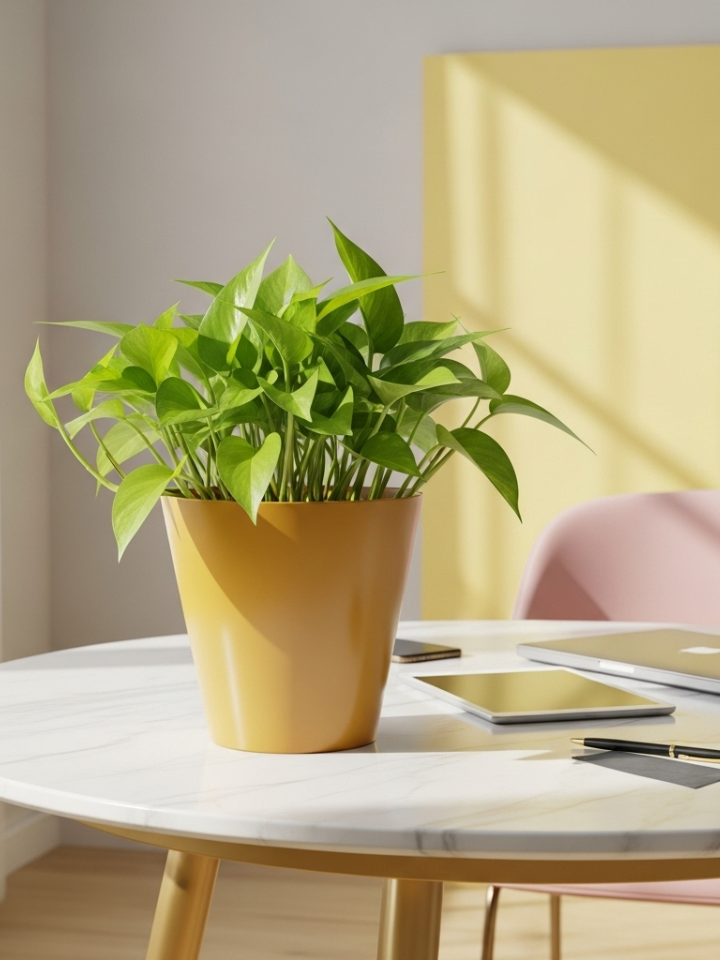

Money Plant (Golden)
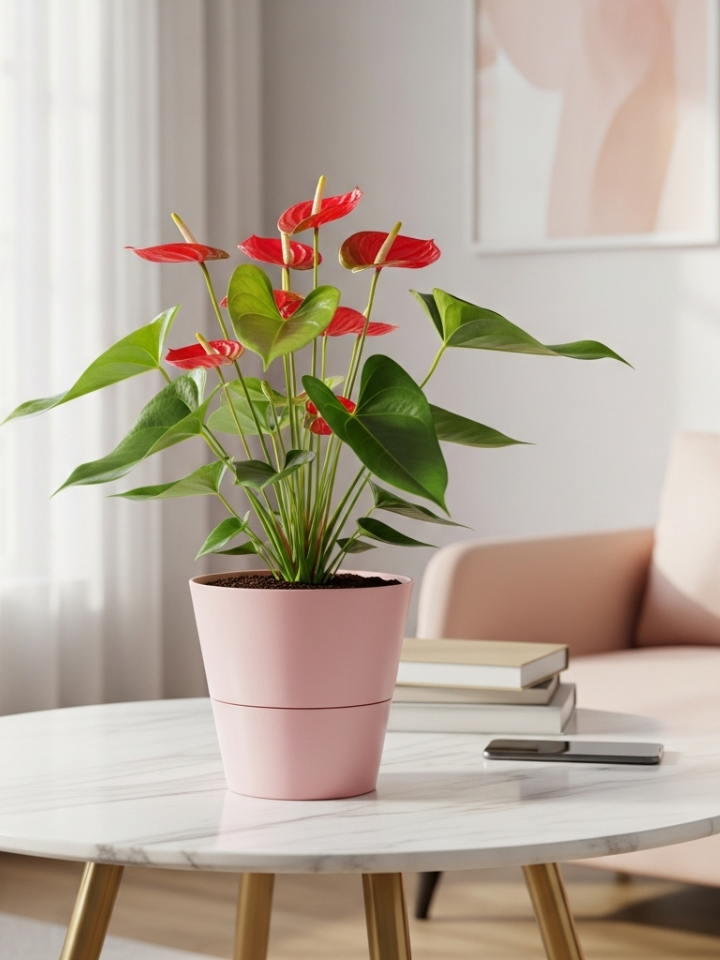
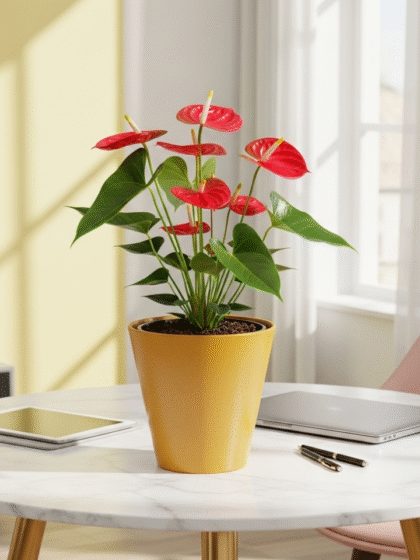
Anthurium Red plant


Snake Plant (Green)
Rank | Plant Name | Key Benefit | Light Requirement | Pet Safety |
1 | Boston Fern (Nephrolepis exaltata) | Absorbs humidity & improves air quality | Indirect or filtered light | Non-toxic to pets |
2 | Peace Lily (Spathiphyllum) | Reduces mold & purifies air | Low to medium light | Mildly toxic to pets |
3 | English Ivy (Hedera helix) | Removes airborne mold spores | Bright, indirect light | Toxic to pets |
4 | Spider Plant (Chlorophytum comosum) | Absorbs moisture & filters toxins | Moderate, indirect light | Non-toxic to pets |
5 | Air Plants (Tillandsia) | Thrive on humidity without soil | Low to bright indirect light | Non-toxic to pets |
Boston Fern – The Classic Humidity Tamer
The Boston Fern is one of the best plants for moisture-heavy areas. Its feathery fronds actively absorb water vapor from the air, helping regulate humidity and prevent mold buildup. Plus, its lush foliage gives your bathroom a soft, tropical look.
Best for: Well-lit bathrooms with indirect sunlight. Hang it in a macramé holder or place it on a high shelf for a cascading green effect.
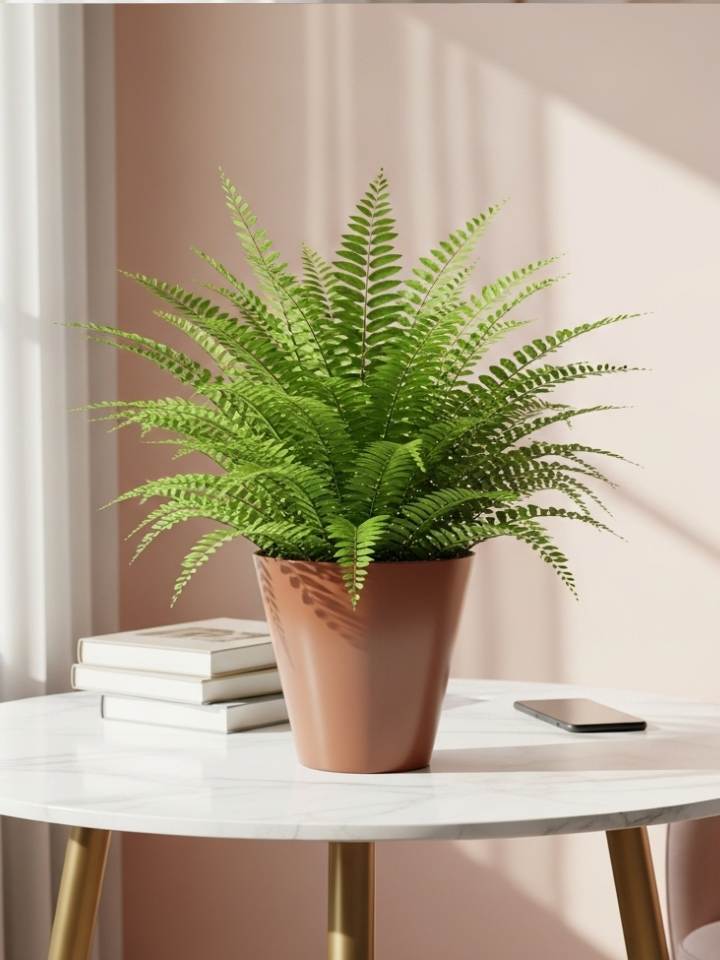

Boston Compacta Fern
In Stock
₹199.00 ₹249.00
In Stock
View Full DetailsPeace Lily – The Elegant Air Purifier
The Peace Lily is a graceful addition to any bathroom. Known for its white blooms and glossy leaves, it not only thrives in humid conditions but also removes mold spores and indoor pollutants like formaldehyde.
Best for: Low-light bathrooms or windowless spaces with artificial lighting. Keep it slightly moist, and it will reward you with a clean, serene atmosphere.
English Ivy – The Mold Fighter
English Ivy is famous for its ability to reduce airborne mold and bacteria, making it ideal for bathrooms prone to mildew. Its trailing vines look beautiful in hanging pots or wall planters.
Best for: Bathrooms with good ventilation and bright, indirect light. Water only when the soil feels dry to prevent overwatering.
Spider Plant – The Beginner’s Favorite
If you’re new to plant care, the Spider Plant is your go-to. It’s incredibly resilient, thrives in humidity, and removes harmful toxins like carbon monoxide and formaldehyde.
Best for: Small bathrooms or pet-friendly homes — this plant is non-toxic and safe for cats and dogs. Place it near a window or on a countertop to add instant freshness.
Air Plants – The Soil-Free Wonders
Air Plants (Tillandsia) are low-maintenance marvels that don’t require soil. They absorb water and nutrients directly from the air, making them perfect for humid spaces like bathrooms. Their unique shapes look stunning in glass terrariums, hanging holders, or mounted on driftwood.
Best for: Minimalist or small bathrooms — just mist them a few times a week or soak them briefly every 10–14 days.
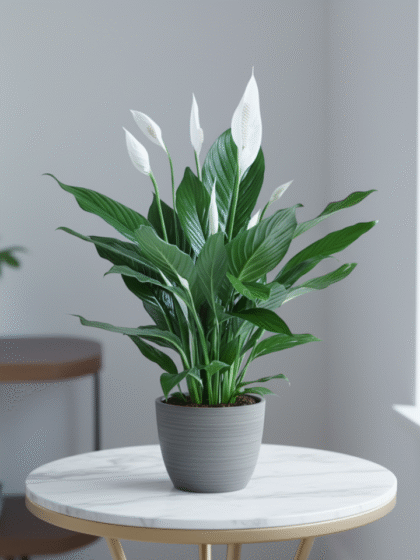
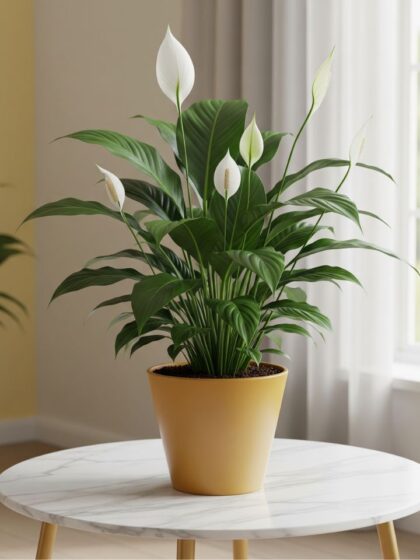
Peace Lily Plant
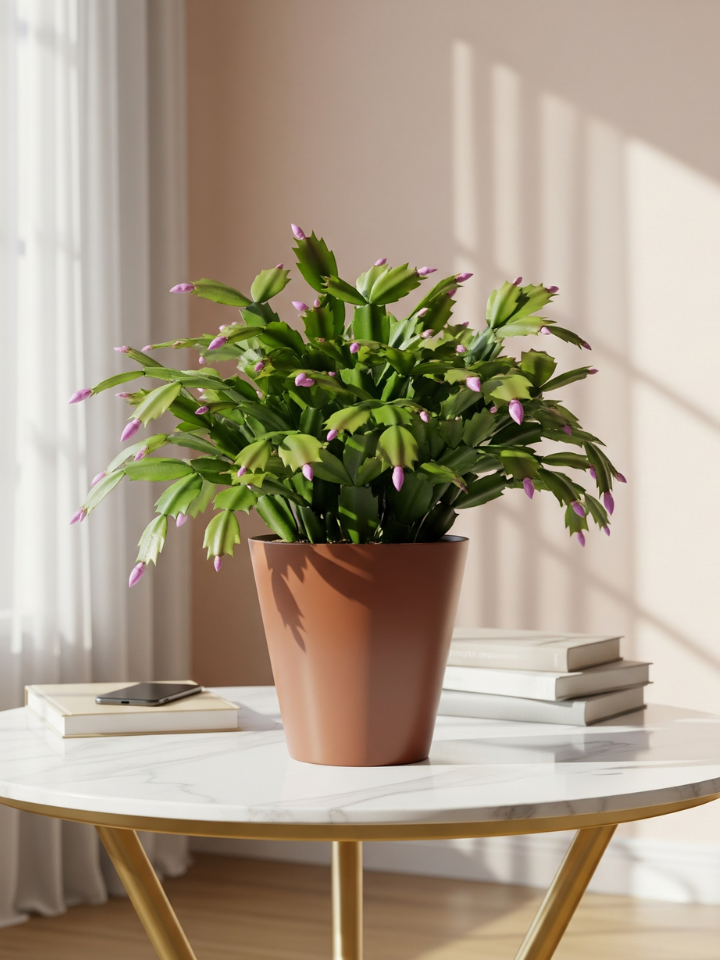
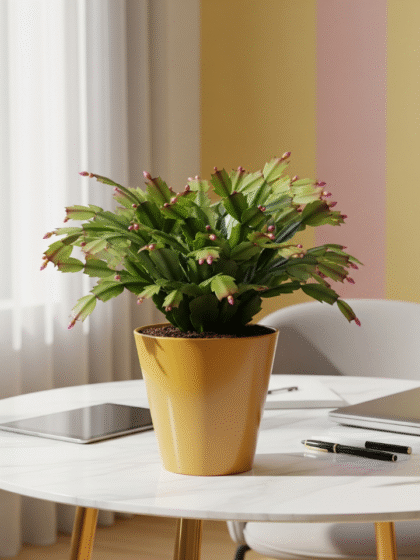
Christmas Cactus

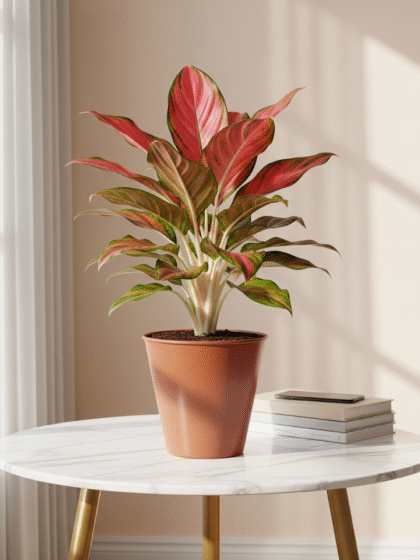
Aglaonema Red Plant


Snake Plant (Golden Hahnii)
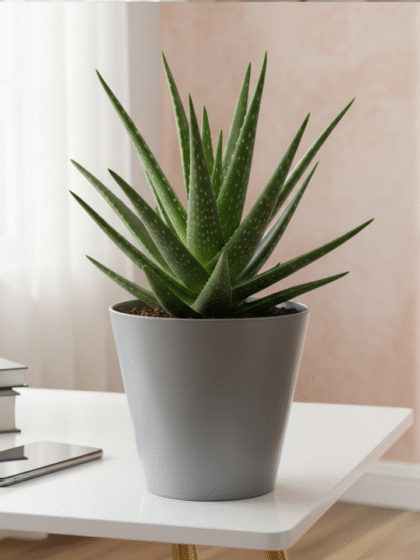
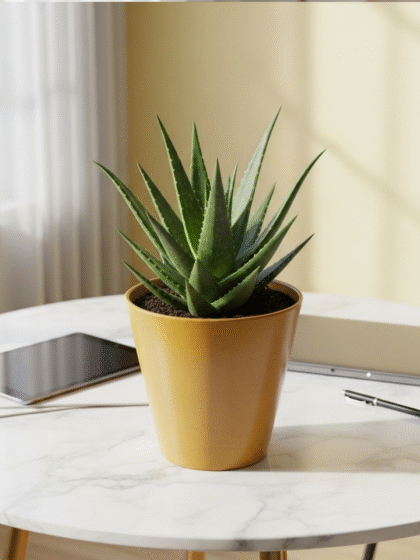
Aloe Vera Mini Plant


Snake Plant (Green)
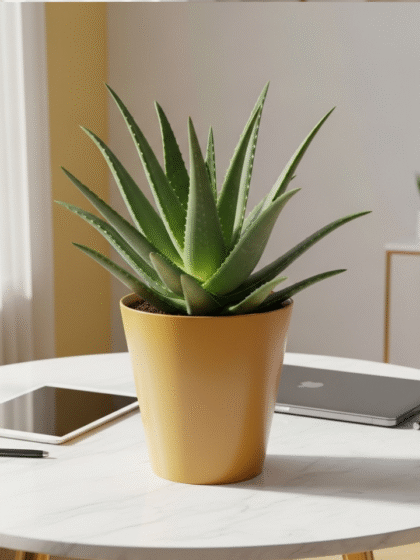
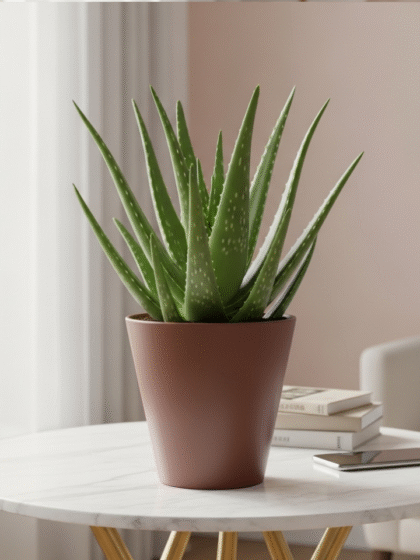
Aloe Vera Blizzard Plant
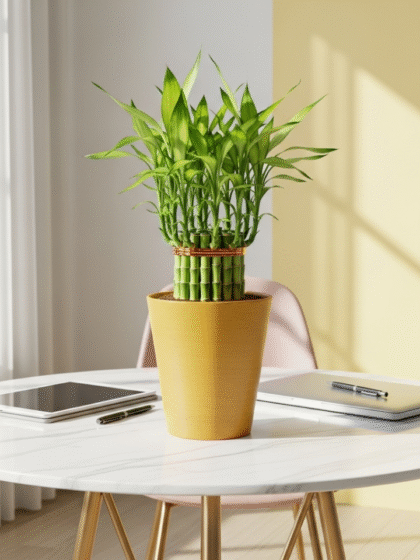
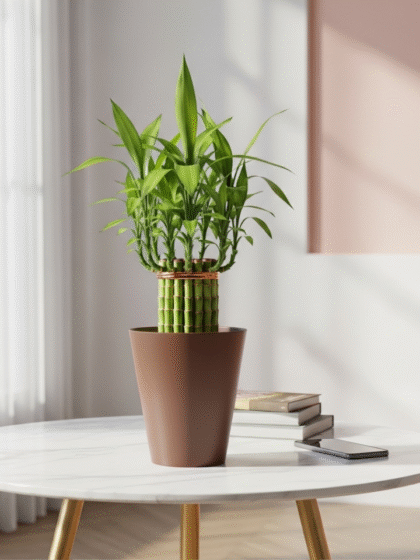
Lucky Bamboo Plant
Placement Ideas for Small and Windowless Bathrooms
Even if your bathroom doesn’t have windows or much space, you can still enjoy the charm and freshness of greenery. The secret lies in creative placement and strategic lighting. With the right setup, your plants can thrive beautifully even in compact or low-light conditions. Here’s how you can bring life into every corner of your bathroom — no matter its size or brightness level.
- Utilize Vertical Space
If floor or counter space is limited, think upward!
- Install floating shelves or corner wall racks to display humidity-loving plants like Spider Plants or Boston Ferns.
- Hanging planters near your shower or vanity add a cascading, jungle-like effect while keeping your surfaces clutter-free.
- Use macramé hangers or ceiling hooks — perfect for English Ivy and Air Plants that love to dangle freely.
- Add Artificial or Grow Lights
For windowless bathrooms, the lack of sunlight doesn’t have to stop you from growing plants.
- Place LED grow lights above or near your plants to mimic natural light.
- Choose low-light tolerant species like Peace Lily, Air Plants, or Pothos.
- A small clip-on or spotlight grow bulb can make a big difference, helping plants stay healthy and vibrant.
- Make Use of Steam Zones
Plants like Boston Ferns and Air Plants love moisture — they thrive on shower steam!
- Place them on a high ledge, window sill, or shower caddy shelf where they can enjoy the humidity without being directly splashed.
- Avoid placing pots directly under a water stream, as constant soaking can cause root rot.
- Mirror Magic
Mirrors can help reflect both light and greenery, making your bathroom feel larger and brighter.
- Position plants near a mirror to double their visual presence.
- This trick also helps spread whatever light source you have — natural or artificial — to other corners of the room.
- Use Compact and Creative Containers
In smaller bathrooms, every inch matters.
- Opt for wall-mounted ceramic planters, glass terrariums, or mini pots for countertops.
- Air Plants are great for hanging holders, while Spider Plants or Peace Lilies fit perfectly in small decorative pots on your sink ledge or vanity shelf.
- Keep Safety and Cleanliness in Mind
If you have pets or children, place plants on higher shelves or hanging hooks to avoid accidents.
Also, ensure water drainage is handled properly — use saucers or lined planters to prevent spills or damp patches.
Care Routine: Watering, Feeding, Cleaning, and Repotting
Caring for bathroom plants is easier than you might think — but it does require a little attention to balance moisture and light. Since bathrooms already have higher humidity, overwatering or neglecting ventilation can quickly stress your plants. Follow this simple, practical care routine to keep your green companions thriving all year long.
- Watering
Humidity in the bathroom can make soil stay moist longer, so it’s important not to overwater.
- Check before watering: Touch the soil — if the top inch feels dry, it’s time to water.
- Avoid soggy roots: Make sure your pots have drainage holes to prevent waterlogging.
- Misting: For ferns and air plants, mist occasionally with a spray bottle to maintain their lush texture.
- Air plants: Instead of soil watering, soak them in clean water for 15–20 minutes every 10–14 days, then dry upside down before returning them to place.
Pro Tip: Use room-temperature filtered water to avoid shocking your plants with hard tap water or chlorine.
- Feeding (Fertilizing)
Your plants need nutrients to stay strong and vibrant.
- Frequency: Feed once a month during the growing season (spring and summer).
- Type: Use a mild liquid fertilizer diluted to half strength.
- Application: Add fertilizer after watering to avoid burning roots.
Ferns and spider plants respond beautifully to regular feeding, while air plants benefit from a light foliar mist using specialized air plant fertilizer.
- Cleaning
Bathrooms can leave plants coated in soap residue or mineral buildup from steam. Clean leaves regularly to help them breathe better.
- Wipe each leaf gently with a soft damp cloth or use a gentle spray of lukewarm water.
- For delicate plants like Boston Ferns, shake them gently or mist clean water over the fronds.
- Avoid chemical cleaners — they can harm the leaf surface and stunt growth.
Bonus Tip: Clean plants not only look healthier but also photosynthesize more efficiently, improving air quality in your bathroom.
- Repotting
Over time, plants outgrow their pots or deplete the nutrients in the soil.
- Frequency: Repot once every 12–18 months.
- Timing: The best time to repot is during spring or early summer.
- Signs it’s time: Roots peeking through drainage holes, slow growth, or water draining too fast.
- Process: Gently remove the plant, shake off old soil, and place it in a slightly larger pot with fresh, well-draining potting mix.
For air plants, there’s no soil to replace — just rinse them occasionally and trim any dead leaves.
- General Maintenance
- Trim dead or yellowing leaves regularly to promote new growth.
- Rotate plants every few weeks so all sides receive even light.
- Ensure good air circulation by opening bathroom doors or windows periodically.
Troubleshooting: Browning Tips, Yellow Leaves, Mold, and Pests
Even the healthiest bathroom plants can show signs of stress from time to time. High humidity, inconsistent lighting, or excess water can lead to issues like yellowing leaves, moldy soil, or browning tips. Fortunately, these problems are easy to fix once you know the cause. Here’s a quick and practical guide to identifying and resolving the most common bathroom plant troubles.
- Browning Tips
Cause: Low humidity, over-fertilization, or chemical-laden water.
Fix:
- Mist leaves regularly to maintain moisture balance.
- Use filtered or distilled water to avoid salt and chlorine buildup.
- Dilute fertilizer to half the recommended strength.
Extra Tip: Trim brown tips neatly with clean scissors — it encourages new growth without harming the plant.
- Yellow Leaves
Cause: Overwatering or poor drainage.
Fix:
- Let the soil dry out slightly between waterings.
- Ensure pots have drainage holes to prevent root rot.
- Move the plant to a brighter spot for improved evaporation.
Note: For plants like Peace Lilies, a few yellow leaves are normal as older foliage dies — simply prune them away.
- Mold on Soil
Cause: Excess moisture and lack of ventilation.
Fix:
- Improve air circulation — open windows or use an exhaust fan.
- Remove the moldy top layer of soil and replace it with fresh, dry potting mix.
- Water less frequently, allowing soil to partially dry out.
Natural Remedy: Sprinkle a little cinnamon powder on the soil surface — it’s a natural antifungal!
- Pests (Mealybugs, Fungus Gnats, and Aphids)
Cause: Warm, damp environments are ideal breeding grounds for pests.
Fix:
- Wipe affected leaves with a soft cloth dipped in neem oil solution or mild soapy water.
- Avoid overwatering — fungus gnats thrive in soggy soil.
- For air plants, rinse them thoroughly and let them dry upside down.
Preventive Tip: Check new plants before bringing them indoors and clean leaves regularly to deter pests.
- Droopy or Wilting Leaves
Cause: Underwatering or poor root health.
Fix:
- Rehydrate by soaking the pot in water for 10–15 minutes, then drain thoroughly.
- For air plants, soak them in clean water and dry them well before returning to place.
- Ensure consistent light exposure for strong, upright growth.
- Fungal or Bacterial Leaf Spots
Cause: Excess moisture on leaves with poor airflow.
Fix:
- Avoid splashing water on leaves; water the soil directly.
- Prune affected leaves immediately.
- Improve ventilation and space out your plants to reduce humidity buildup.
Quick Safety Summary
Plant Name | Safe for Pets? | Allergy Risk | Recommendation |
Spider Plant | ✅ Yes | Low | Ideal for all homes |
Boston Fern | ✅ Yes | Moderate (spores) | Great for well-ventilated areas |
Air Plants | ✅ Yes | Very Low | Perfect for windowless bathrooms |
Peace Lily | ❌ No | Moderate (pollen) | Keep on shelves |
English Ivy | ❌ No | Low | Hang high or use artificial ivy alternatives |
FAQs: No-Window Bathrooms, Shower Steam, and Grow Lights
If you’re new to bathroom plants, you probably have a few questions about how to keep them alive in low light and high humidity. Don’t worry — we’ve got you covered! Below are some of the most common questions plant lovers ask about caring for moisture-absorbing bathroom plants, along with simple, expert-approved answers.
Absolutely! Many tropical plants naturally grow in shaded rainforest environments, so they’re well-suited for windowless bathrooms.
Plants like Peace Lily, Air Plants (Tillandsia), and Pothos thrive under artificial grow lights or even LED bulbs if placed nearby.
Tip: Keep the light on for at least 10–12 hours a day to mimic daylight. A small timer plug can automate this for you!
Yes — in fact, it’s one of the best things for them! Warm steam increases humidity levels, which plants like Boston Ferns and Air Plants absolutely love.
Just make sure:
- The plants are not placed directly under the shower stream.
- Water doesn’t collect at the base of pots, as it can cause root rot.
Bonus: The steam helps clean plant leaves naturally, keeping them dust-free and glossy.
Not always. Some plants manage well with ambient lighting from ceiling or vanity bulbs. But if your bathroom is completely windowless or receives zero sunlight, LED grow lights are worth investing in.
They:
- Mimic natural sunlight.
- Promote healthy, vibrant growth.
- Are energy-efficient and safe for indoor spaces.
Choose full-spectrum LED grow bulbs and position them 6–12 inches above your plants for best results.
Because of high humidity, most bathroom plants need less frequent watering than other indoor plants.
- Check the soil moisture before watering — if it feels damp, wait a few days.
- Plants like Air Plants or Boston Ferns prefer misting instead of heavy watering.
Pro Tip: Overwatering is a bigger risk than underwatering in humid rooms!
Yes! Plants like Peace Lily, Spider Plant, and English Ivy are natural air purifiers. They absorb toxins such as formaldehyde and benzene from cleaning products, while neutralizing unpleasant odors.
For best results, group two or three small plants together to enhance air filtration and create a refreshing, clean scent.
Try vertical arrangements and hanging planters to save space.
- English Ivy looks beautiful draping from a high shelf.
- Air Plants fit perfectly in glass terrariums or wall holders.
- Spider Plants love floating shelves or corner racks.
Idea: Mix plant textures and heights to create a layered, tropical effect — even in compact bathrooms!
Strong chemical fragrances can irritate sensitive plants over time.
If you love fragrances, choose natural soy candles, essential oil diffusers, or plant-safe air fresheners instead. They keep your space smelling fresh without harming delicate foliage.
If you’re just starting, go for Spider Plant, Air Plant, or Peace Lily. They are forgiving, low-maintenance, and adapt well to changing light and humidity levels.
Conclusion: Next Steps and Easy Starter Picks
Transforming your bathroom into a green oasis isn’t just about aesthetics — it’s about creating a sanctuary that breathes freshness, balance, and calm into your daily routine. The gentle sway of ferns, the glossy leaves of a peace lily, or the sculptural beauty of air plants can instantly elevate even the smallest space. More importantly, these plants silently work behind the scenes, absorbing excess humidity, reducing mold, and purifying the air — turning your bathroom into a natural wellness zone.
Whether your bathroom is bright and airy or small and windowless, there’s a plant that can thrive beautifully in it. If you’re new to indoor gardening, start simple. The Spider Plant is perfect for beginners — it’s hardy, adaptable, and safe for pets. The Boston Fern, with its lush green fronds, adds a soft tropical charm, while the Peace Lily brings elegance and fragrance to your bathroom corners. For modern, minimal spaces, Air Plants are a dream come true — no soil, no mess, just mist and love.
Creating a bathroom full of plants is also about slowing down and reconnecting with nature. In the middle of your busy mornings or long, tiring days, those tiny green leaves remind you to pause, breathe, and find peace. They make your bathroom not just functional, but restorative — a place where nature quietly heals and rejuvenates you.
So, if you’ve been thinking about adding a little greenery to your bathroom, don’t wait. Start with one plant, watch it thrive, and soon you’ll find yourself building your own lush, indoor jungle. From moisture-absorbing ferns to air-purifying lilies, every plant has its story — and your bathroom is the perfect place for it to unfold.
Ready to get started? Explore our exclusive collection of indoor bathroom plants, curated for Indian homes and tropical climates, at Plantaeroot — and bring nature closer, one leaf at a time.
